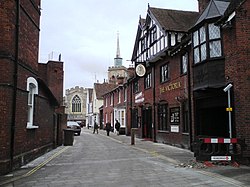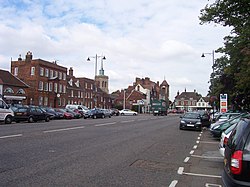Baldock
| Baldock | |
| Hertfordshire | |
|---|---|
 Sun Street, Baldock | |
| Location | |
| Grid reference: | TL247337 |
| Location: | 51°59’23"N, 0°11’20"W |
| Data | |
| Population: | 9,900 |
| Post town: | Baldock |
| Postcode: | SG7 |
| Dialling code: | 01462 |
| Local Government | |
| Council: | North Hertfordshire |
| Parliamentary constituency: |
North East Hertfordshire |
Baldock is a historic market town in northern Hertfordshire close to the Bedfordshire border and 14 miles north-north-west of the county town, Hertford. Nearby towns include Letchworth and Hitchin to the southwest and Stevenage to the south. The River Ivel rises near the town.
Churches
The parish church is St Mary's, a thirteenth-century building.
- Church of England: St Mary's
- Independent evangelical: Christ Church Baldock
History
Baldock is said to have been founded by the Knights Templar in at some time between 1138 and 1148, carved out of the manor of Weston. One theory for the origin of the town's name is a derivation from the Old French name for Baghdad: Baldac[1] which the Templars had hoped to conquer during the Crusades. A rival etymology, suggesting a derivation from "Bald Oak", perhaps meaning a dead oak, is plausible, but the early forms of the name are against it. A market was established in 1199.
The modern layout of the town, and many buildings in the centre, date from the sixteenth century, with the earliest dating from the fourteenth century.
The town grew up where the old Great North Road and the Icknield Way crossed. Despite the construction of the A1(M) motorway in 1963, which bypassed the town (and which was called the Baldock Bypass for some years), it was still a major traffic bottleneck until March 2006, when a new bypass removed the A505 road (part of the old Icknield Way to the east of Baldock) from the town.
Thanks to its location, the town was a major staging post between London and the north: many old coaching inns still operate as pubs and hotels, and Baldock has a surprising number of pubs for its size. The high street is very wide, a typical feature of mediæval market places where more than one row of buildings used to stand. In the case of Baldock, the bottom of the High Street had three such rows, until Butcher's Row was demolished by the Turnpike authorities in the 1770s. Until 2008 this width was taken up by the carriageway but then a town centre enhancement plan was effected included a narrowing of the road (eliminating the convenient parking spaces in the middle of the road) and subsequent widening of paved areas.

Since the 16th century, Baldock has been a centre for malting, subsequently becoming a regional brewing centre with at least three large brewers still operating at the end of the 19th century, despite a decline in demand for the types of beer produced locally. The 1881 Census records approximately 30 drinking establishments (the town's population was at that time around 1900). Throughout the early 20th century a large number of pubs continued to operate, many of which were sustained by the adjacent and much larger town of Letchworth, which had no alcohol retailers before 1958, and had only two pubs and a single hotel bar until the mid 1990s. Its larger population had for many years visited both Baldock and Hitchin for refreshment.
The Wynn almshouses, in the High Street, were founded in 1621 and were endowed "To the World's End" by John Wynne, a cloth merchant from London who left £1000 in his will of 1614 for their upkeep.[2]
Since 1850, the town has a railway station which today operates on the line between London Kings Cross and Cambridge. With frequent services to London, including fast services of around 30 minutes, the town is home to many commuters.
There has been human activity on the site well before the modern town was founded. Prehistoric remains on Clothall Common date back as far as c 3000 BC.[3] Many Roman remains have been discovered during building work in and around the town, and the core of the Roman settlement lies between Walls Field and Bakers Close. Earlier Iron Age remains have also been uncovered in the same general location, which may be the earliest town ever to develop in Britain.
A mediæval leper colony, on Royston Road, was located during excavations in 2003, having been thought for many years to lie to the south-east of the town on the former Pesthouse Lane (now Clothall Road), the A507.
From 1808 to 1814, Baldock hosted a station in the shutter telegraph chain that connected the Admiralty in London to its ships in the port of Great Yarmouth.
An authoritative history of "Baldock's Middle Ages" (ISBN 0-905858-97-2) was compiled by Vivian Crellin, a former headmaster of the Knights Templar School, while local archaeologists Keith Fitzpatrick-Matthews and Gilbert Burleigh published 'Ancient Baldock: the story of an Iron Age and Roman town' in 2007.
Baldock's position at the crossing of two important thoroughfares, the Great North Road and the Icknield Way has made it a stopping point for a number of illustrious visitors, including Charles I, who passed through Baldock on the way to London after his arrest in 1648[4] and supposedly Dick Turpin.
John Wesley came to the town in 1747 and preached.[5]
In the 1960s and 70s Baldock was a centre of laser research at a MOD laboratory called SERL (Services Electronics Research Laboratory). This facility closed in the late 1970s and some projects and staff were transferred to RSRE (Royal Signals & Radar Establishment) near Pershore.
Baldock was formerly the location of a film processing factory which folded before the company (originally based in Letchworth Garden City) could move in; local folklore has it that it was a silent film studio, but this is not the case.[6] The building was then bought by the Full-Fashioned Hosiery Company from Halifax, later becoming the Kayser Bondor ladies stocking factory (which temporarily produced parachutes during Second World War). Its Art Deco facade still stands as the largest Listed Building in the town; it was converted to a Tesco supermarket in the late 1980s. Malting and brewing were formerly major industries in the town, but apart from some light industry, today it is mostly a commuter town.
In the past few years, many businesses have shut down in Baldock. Baldock lost its local football team, Baldock Town FC in 2001, after nearly 100 years of existence.
Events
Several events take place in Baldock throughout the year. The largest two are the Festival and the Charter Fair.
Baldock Festival
The Baldock Festival is a cultural festival which started in 1983 and takes place on the first weekend in May. The festival consists of numerous events throughout the town and the local area, such as museum trips, a barn dance, car treasure hunt, clairvoyance evening, cricket match, comedy sketches, family quiz night, mystery tour, open gardens, history talks, and several music events, some of which feature local bands. The festival culminates in the Mediæval Street Fair held in the historic High Street, on the second and final weekend where many stallholders dress in clothing of the era and help to portray what life was like in the mediæval town.
Beer festival
The Baldock Beer Festival also takes place during the first weekend in May where local and national real ales, real ciders and continental lagers may be sampled. There is also children's entertainment and often local bands playing.
Baldock Charter Fair
Baldock's Charter fair dates back to 1199, when King John granted to the Templars the right of holding a yearly fair at Baldock on St Matthew's Day and for four days following.[7]
The original fair would have been held on 21–25 September, but with the Calendar reform of 1752 the dates are now 2, 3 and 4 October. Today the principal part of the fair is a visiting Amusement Fair which sets up in the High Street.
Baldock in literature
Jack o' Legs is a legendary 14th century "giant" associated with the town
Daniel Defoe, in his book A tour through the whole island of Great Britain, passed through Baldock and wrote:
Here is that famous Lane call'd Baldock Lane, famous for being so unpassable, that the Coaches and Travellers were oblig'd to break out of the Way even by Force, which the People of the Country not able to prevent, at length placed Gates, and laid their lands open, setting Men at the Gates to take a voluntary Toll, which Travellers always chose to pay, rather than plunge into Sloughs and Holes, which no Horse could wade through."[8]
"Ruined City," by Nevil Shute has Baldock as one of the waypoints on Warren's long drive up the Great North Road, which brings about the occasion for the novel's plot, the rescue of the shipbuilding town of 'Sharples' (Blyth).
The author Monica Dickens, who lived in nearby Hinxworth for four years after Second World War, refers to her regular visits to Baldock and to The George and Dragon public house in particular, in her 1978 autobiography An Open Book.[9]
Baldock is mentioned frequently in the supernatural thriller The Green Man by Kingsley Amis (1969). The town is the nearest local centre to the fictional pub owned and run by the main character "Maurice Allington". The Green Man was later adapted into a television drama starring Albert Finney as Allington.
Outside links
| ("Wikimedia Commons" has material about Baldock) |
- Baldock Museum and Local History Society
- Baldock (A Guide to Old Hertfordshire)
- Photographs of Baldock
- Baldock Midnight Morris
References
- ↑ Eilert Ekwall (1981). The Concise Oxford Dictionary of English Place-names. Oxford: OUP. pp. 24. ISBN 0-19-869103-3.
- ↑ AA Touring Guide of England, 1974, PAGE 138, ISBN 0-09-211550-0
- ↑ Gilbert R Burleigh and Keith J Fitzpatrick-Matthews (2010). Excavations in Baldock 1978-1994, volume 1: an Iron Age and Romano-British cemetery at Wallington Road. Letchworth Garden City: North Hertfordshire District Council Museums & North Hertfordshire Archaeological Society. pp. 21. ISBN 978-0-9554116-5-6.
- ↑ Parish Church – history
- ↑ [1] A Vision of Britain Through Time: John Wesley
- ↑ Moira Keast (2007). The Story of Kayser Bondor. Baldock [Eng.]: Baldock Museum and Local History Society. pp. 13–14.
- ↑ William Page (editor) (1912). "Parishes: Baldock". A History of the County of Hertford: volume 3. British History Online. http://www.british-history.ac.uk/report.aspx?compid=43582. Retrieved 26 March 2010.
- ↑ Daniel Defoe's Tour Through the Whole Island of Great Britain, 1726
- ↑ Dickens, Monica An Open Book, Mayflower Books/Heinemann (1978) pgs 111-122
